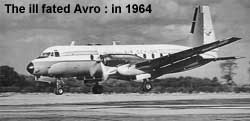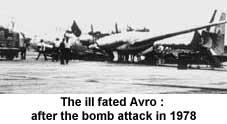 |
 6th September 1998 |
Front Page| |
Tomorrow is the 20th anniversaryThe day the Avro was bombedBy Roger ThiedemanSome day someone will write the definitive his- tory of Sri Lanka's tragic Eelam conflict. But before that happens the war must end. And when that story is written, September 7, 1978 will stand out as a milestone. It was the day when one of the earliest blows in the separatist struggle was struck, the day when aviation terrorism first reared its ugly head in Sri Lanka. But first, let's go back to a happier day in 1964. On Friday October
30, a large crowd of VIPs, officials and well-wishers gathered at Ratmalana
airport to greet the arrival of Air Ceylon's newest acquisition. The brand-new
Hawker-Siddeley (Avro) 748 turboprop aircraft, registered 4R-ACJ, symbolised
Air Ceylon's new-found status as an independent operator of jet-powered
equipment. And when Capt. P.B. Mawalagedera and Capt. George Ferdinand emerged from the gleaming 48-seat Avro at the end of its delivery flight from Manchester to Colombo, they were accorded a heroes' welcome by the waiting crowd. Over the next few weeks the Avro, or 'ACJ' to use its registration identity, was kept busy operating demonstration flights. While providing the opportunity to train more pilots on the new aircraft, these joy flights enabled all strata of Air Ceylon staff, government officials, representatives of the press and travel industry, and even a few delighted members of the Maha Sangha, to sample the smoothness of turbine flight high above the scenic splendour of Ceylon. Monday November 9, 1964 soon arrived. This was the day when Air Ceylon's new turboprop would operate its first revenue service to Bombay. Again, a large crowd of airline officials and politicians had gathered outside the Air Ceylon hangar to witness the momentous departure. Inside the hangar, a tractor and towbar were coupled up to the Avro. An engineer in the cockpit steered the plane's nosewheel as the aircraft began to be slowly towed outside. Suddenly, disaster struck. One of those involved in the towing operation misjudged the height of the aircraft, and its tail fin came into sickening contact with the arched hangar roof: In full view of the assembled VlPs, the fin and rudder assembly were all but wrenched off, crippling the still-new airplane that had yet to contribute a cent to Air Ceylon's coffers. The so-called 'inaugural' flight eventually went ahead after one of the airline's old faithful DC-3s was hurriedly pressed into service. Replacement parts for the damaged Avro were ordered from the United Kingdom, and not until several weeks later did it take to the air again, to start earning its keep. Although the memory of the accident gradually receded, one wonders whether it was a portent of things to come for Avro 748 4R-ACJ. Over the next decade and more, the Avro proved a reliable, rugged performer, popular with pilots, engineers and passengers alike. It flew tirelessly all over Air Ceylon's domestic and regional network, from Ratmalana to places like Kankesanturai (Jaffna/Palaly), Trincomalee (China Bay), Anuradhapura, to the Indian cities of Trichinopoly, Madras and Bombay, and even to Male in the Maldive Islands. But nearly fourteen years after 'ACJ' first landed at Ratmalana amidst adulation and national pride, it entered the history books for the wrong reasons. Thursday September 7, 1978 was a day like any other.
It certainly started out in routine fashion for Capt. Errol Cramer who
flew 'ACJ' from Ratmalana to Jaffna on the early morning Air Ceylon service.
Assisting him in the cockpit was First Officer Trevor Vanderstraaten. After
an uneventful turn-around at Sri Lanka's northernmost airport, the Avro
returned to Ratmalana, landing at approximately 8.30 am. Their duty over, the two pilots prepared to leave the aircraft. They noticed the cabin not quite empty of passengers — two male 'stragglers' yet to disembark appeared to be retrieving items of luggage from beneath their seats. Cramer and Vanderstraaten may have finished their flying for the day, but no such respite was planned for Avro 'ACJ'. It was scheduled to leave soon on a ferry, or positioning, flight (without passengers) to Katunayake airport, where it would collect a load of tourists destined for the Maldives. A new crew comprising Capt. Ronnie Perera and First Officer Ranjit Pedris were ready to take over for the flight to Male via Katunayake. But when Capt. Perera entered the Avro he noticed that the passenger cabin was in an untidy state, with rubbish strewn everywhere. He ordered that the cabin be cleaned before the ferry flight, rejecting co-pilot Pedris's suggestion to have the cleaning performed at Katunayake instead. That decision, delaying take-off, would save both their lives. Minutes ticked by as Ranjit Pedris carried out his pre-flight checks in the cockpit. Capt. Perera remained in the cabin supervising the cleaner. And then it happened. A deafening blast from near the middle of the aircraft shook the confines of the cabin. As a shock wave assailed his ears, Pedris looked back from his pilot's seat to find the cabin engulfed in flames. Noticing that the fire was in the vicinity of the Avro's fuel tanks, he wasted no time in leaping up and running out through the open front door. Meanwhile, Capt. Ronnie Perera and the cleaner, miraculously uninjured by the explosion or fire, also made a hasty exit via the rear passenger door. Fortunately that door had not been shut, because the rapidly spreading flames would have blocked their access to the only other door, the front one that Pedris had used. Having heard and seen the explosion, the control tower staff promptly sounded the fire alarm. But, according to an eyewitness, what occurred next resembled a scene from a Keystone Kops or Charlie Chaplin comedy film. Although the sight of the burning Avro was no laughing matter. A fire engine arrived soon enough, but the crew then had difficulty locating the fire hydrants. When hoses were finally connected to the water supply, they found that water pressure was inadequate, a situation not helped by leaks in the hose pipes. Worse still, the firefighters could not get close enough to the fire because their protective asbestos suits and masks were locked away in a cupboard, the key to which had been removed by the senior airport fire officer who was under interdiction orders at the time! Then, an ambulance racing from Colombo to Ratmalana airport caught fire at Kollupitiya. While this farcical drama played itself out, the raging inferno quickly gained the upper hand. The fire spread relentlessly and the Avro began to writhe in its death throes, literally melting away before the incredulous, helpless onlookers. While the middle section, where the fire had originated, was reduced to almost nothing, the tail sagged to the ground; simultaneously, the nose of the aircraft, including cockpit and front wheels, twisted sideways through 90 degrees before it too sank onto the tarmac. The sight almost brought tears to the eyes of Timothy de Alwis, now a senior Air Lanka engineer, who was then working in a similar capacity for Air Ceylon. Luckily, the flames did not reach the Avro's fuel tanks, or an even greater calamity would have resulted. When the fire was finally extinguished, it was all too late. No human lives were lost but the Avro was dead, a twisted, charred hulk, only the two wings and engines remaining substantially intact. Investigators found that the explosion was caused not by any mechanical failure or fault of the aircraft but, in all likelihood, by a bomb or similar explosive device. They believed that damage from the explosion may have been repairable if only the fire had not been allowed to take hold. If only the firemen had the appropriate firefighting equipment. If only the keys to the cupboard had not been taken away by the interdicted officer. If only the water pressure was stronger. If only the hoses didn't leak. But there was another more important 'if'. If Capt. Ronnie Perera had not delayed his departure by having the interior cleaned at Ratmalana, and not at Katunayake as had been suggested, the bomb would have exploded while the Avro was in mid-air en route from Ratmalana to Katunayake. Not only the two pilots, but people on the ground too might have been killed as pieces of the flaming Avro fell to earth. Now there were questions demanding answers. Who placed the bomb on board the plane? Was the bomb linked to those two passengers seen loitering in the cabin by Capt. Errol Cramer? Already, a cordon had been placed around Ratmalana airport to detain passengers who had just arrived from Jaffna aboard the Avro, but no suspects were apprehended at that stage. Much later, two men who had travelled on the Avro's final flight were arrested, tried and sentenced for their crime of placing a bomb under a seat before they de-planed. They were found to be activists in an embryonic terrorist movement which later grew into the organisation known today as the Liberation Tigers of Tamil Eelam (LTTE). Their plan to destroy government property and innocent lives had only partly succeeded. But these agents of evil had managed to introduce the spectre of aircraft bombing and terrorism into hitherto untroubled Sri Lankan aviation. And they also helped to seal the fate of Sri Lanka's first national carrier, already crippled by impoverished finances, inept management and insufficient aircraft. The loss of Avro 4R-ACJ was almost the last nail in the coffin of Air Ceylon, which struggled to survive but faded into oblivion less than a year later. |
||
 |
More Plus * 'Rights, for us?'
Front Page| News/Comment| Editorial/Opinion| Business| Sports | Mirror Magazine |
|
 |
Please send your comments and suggestions on this web site to |
|

